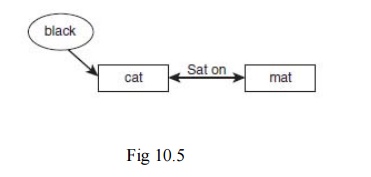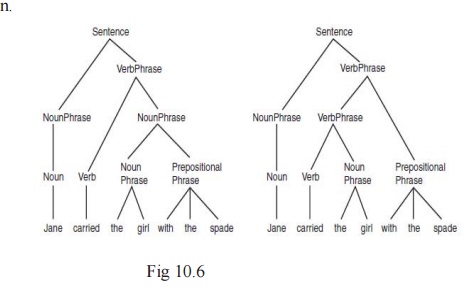Chapter: Artificial Intelligence
Semantic Analysis
Semantic Analysis
Semantics is the study of the meaning of words, and
semantic analysis is the analysis we use to extract meaning from utterances.
Semantic analysis involves building up a
representation of the objects and actions that a sentence is describing,
including details provided by adjectives, adverbs, and prepositions. Hence,
after analyzing the sentence The black cat sat on the mat, the system would use
a semantic net such as the one shown in Figure 10.5 to represent the objects
and the relationships between them.

A more sophisticated semantic network
is likely to be formed, which includes information about the nature of a cat (a
cat is an object, an animal, a quadruped, etc.) that can be used to deduce
facts about the cat (e.g., that it likes to drink milk).
Ambiguity and Pragmatic Analysis
One of the main differences between
natural languages and formal languages like C++ is that a sentence in a natural
language can have more than one meaning. This is ambiguity—the fact that a
sentence can be interpreted in different ways depending on who is speaking, the
context in which it is spoken, and a number of other factors.
The more common forms of ambiguity
and look at ways in which a natural language processing system can make
sensible decisions about how to disambiguate them.
Lexical ambiguity occurs when a word
has more than one possible meaning. For example, a bat can be a flying mammal
or a piece of sporting equipment. The word set is an interesting example of
this because it can be used as a verb, a noun, an adjective, or an adverb.
Determining which part of speech is intended can often be achieved by a parser
in cases where only one analysis is possible, but in other cases semantic
disambiguation is needed to determine which meaning is intended.
Syntactic ambiguity occurs when there
is more than one possible parse of a sentence. The sentence Jane carried the
girl with the spade could be interpreted in two different ways, as is shown in
the two parse trees in Fig 10.6. In the first of the two parse trees in Fig
10.6, the prepositional phrase with the spade is applied to the noun phrase the
girl, indicating that it was the girl who had a spade that Jane carried. In the
second sentence, the prepositional phrase has been attached to the verb phrase
carried the girl, indicating that Jane somehow used the spade to carry the
girl.
Semantic ambiguity occurs when a
sentence has more than one possible meaning—often as a result of a syntactic
ambiguity. In the example shown in Fig 10.6 for example, the sentence Jane
carried the girl with the spade, the sentence has two different parses, which
correspond to two possible meanings for the sentence. The significance of this
becomes clearer for practical systems if we imagine a robot that receives vocal
instructions from a human.

Referential ambiguity occurs when we use anaphoric
expressions, or pronouns to refer to objects that have already been discussed.
An anaphora occurs when a word or phrase is used to refer to something without
naming it. The problem of ambiguity occurs where it is not immediately clear
which object is being referred to. For example, consider the following
sentences:
John gave Bob the sandwich. He smiled.
It is not at all clear from this who smiled—it
could have been John or Bob. In general, English speakers or writers avoid
constructions such as this to avoid humans becoming confused by the ambiguity.
In spite of this, ambiguity can also occur in a similar way where a human would
not have a problem, such as
John gave the dog the sandwich. It wagged its tail.
In this case, a human listener would know very well
that it was the dog that wagged its tail, and not the sandwich. Without
specific world knowledge, the natural language processing system might not find
it so obvious.
A local ambiguity occurs when a part of a sentence
is ambiguous; however, when the whole sentence is examined, the ambiguity is
resolved. For example, in the sentence There are longer rivers than the Thames,
the phrase longer rivers is ambiguous until we read the rest of the sentence,
than the Thames.
Another cause of ambiguity in human language is
vagueness. we examined fuzzy logic, words such as tall, high, and fast are vague and do not have precise
numeric meanings.
The process by which a natural
language processing system determines which meaning is intended by an ambiguous
utterance is known as disambiguation.
Disambiguation can be done in a
number of ways. One of the most effective ways to overcome many forms of
ambiguity is to use probability.
This can be done using prior
probabilities or conditional probabilities. Prior probability might be used to
tell the system that the word bat nearly always means a piece of sporting
equipment.
Conditional probability would tell it
that when the word bat is used by a sports fan, this is likely to be the case,
but that when it is spoken by a naturalist it is more likely to be a winged
mammal.
Context is also an extremely
important tool in disambiguation. Consider the following sentences:
I went into the cave. It was full of
bats.
I looked in the locker. It was full
of bats.
In each case, the second sentence is
the same, but the context provided by the first sentence helps us to choose the
correct meaning of the word “bat” in each case.
Disambiguation thus requires a good
world model, which contains knowledge about the world that can be used to
determine the most likely meaning of a given word or sentence. The world model
would help the system to understand that the sentence Jane carried the girl
with the spade is unlikely to mean that Jane used the spade to carry
the girl because spades are usually used to carry
smaller things than girls. The challenge, of course, is to encode this
knowledge in a way that can be used effectively and efficiently by the system.
The world model needs to be as broad as the
sentences the system is likely to hear. For example, a natural language
processing system devoted to answering sports questions might not need to know
how to disambiguate the sporting bat from the winged mammal, but a system designed
to answer any type of question would.
Related Topics